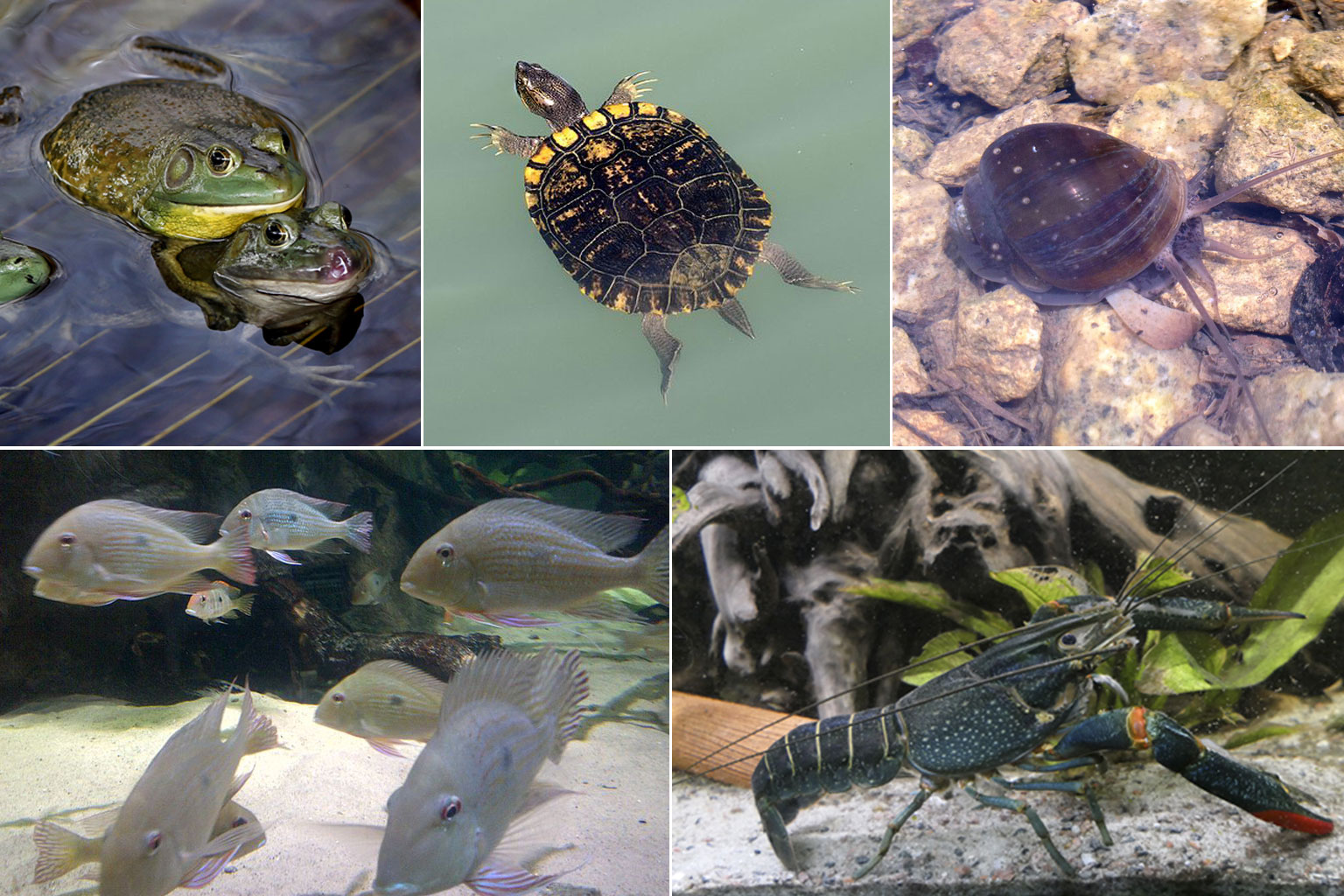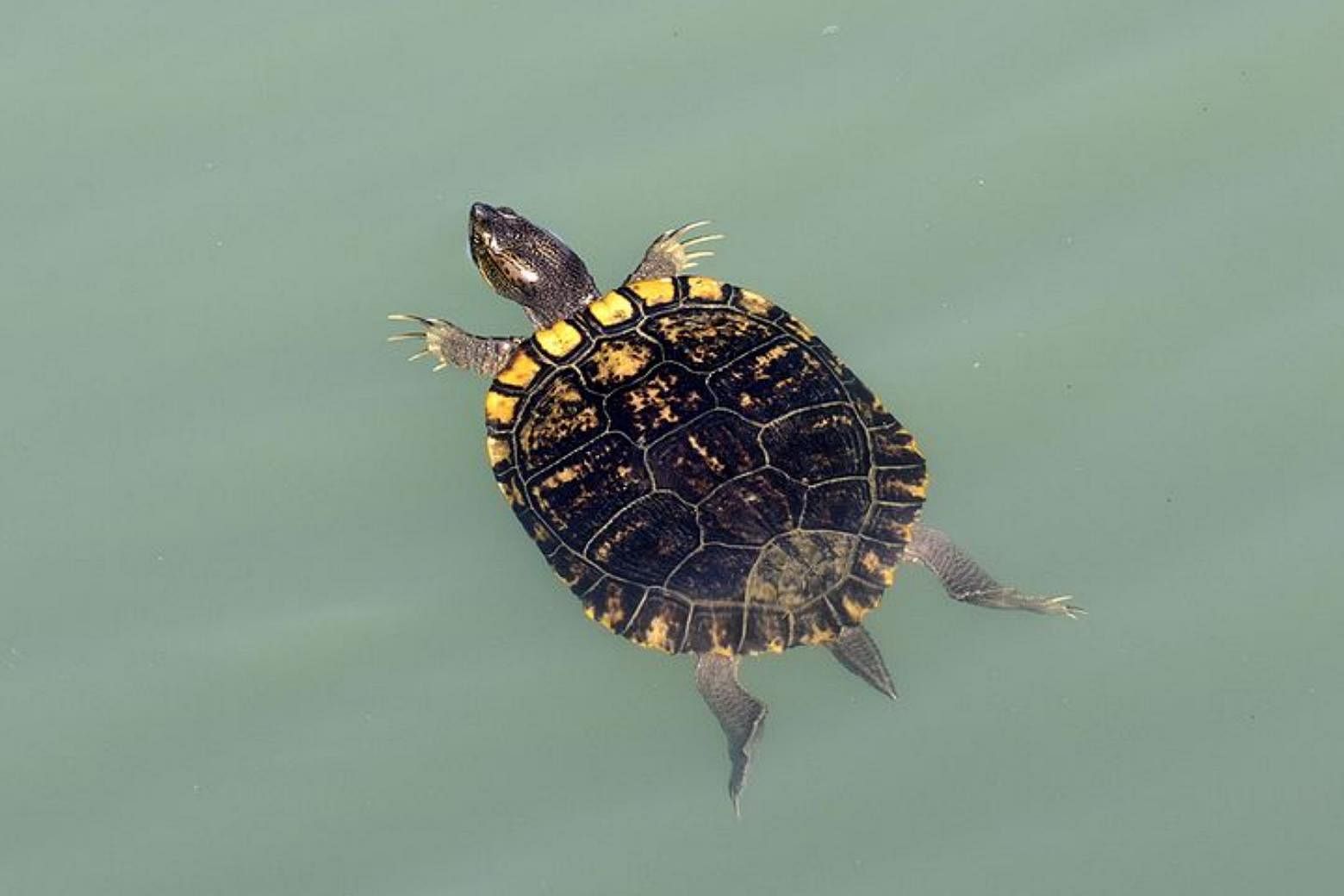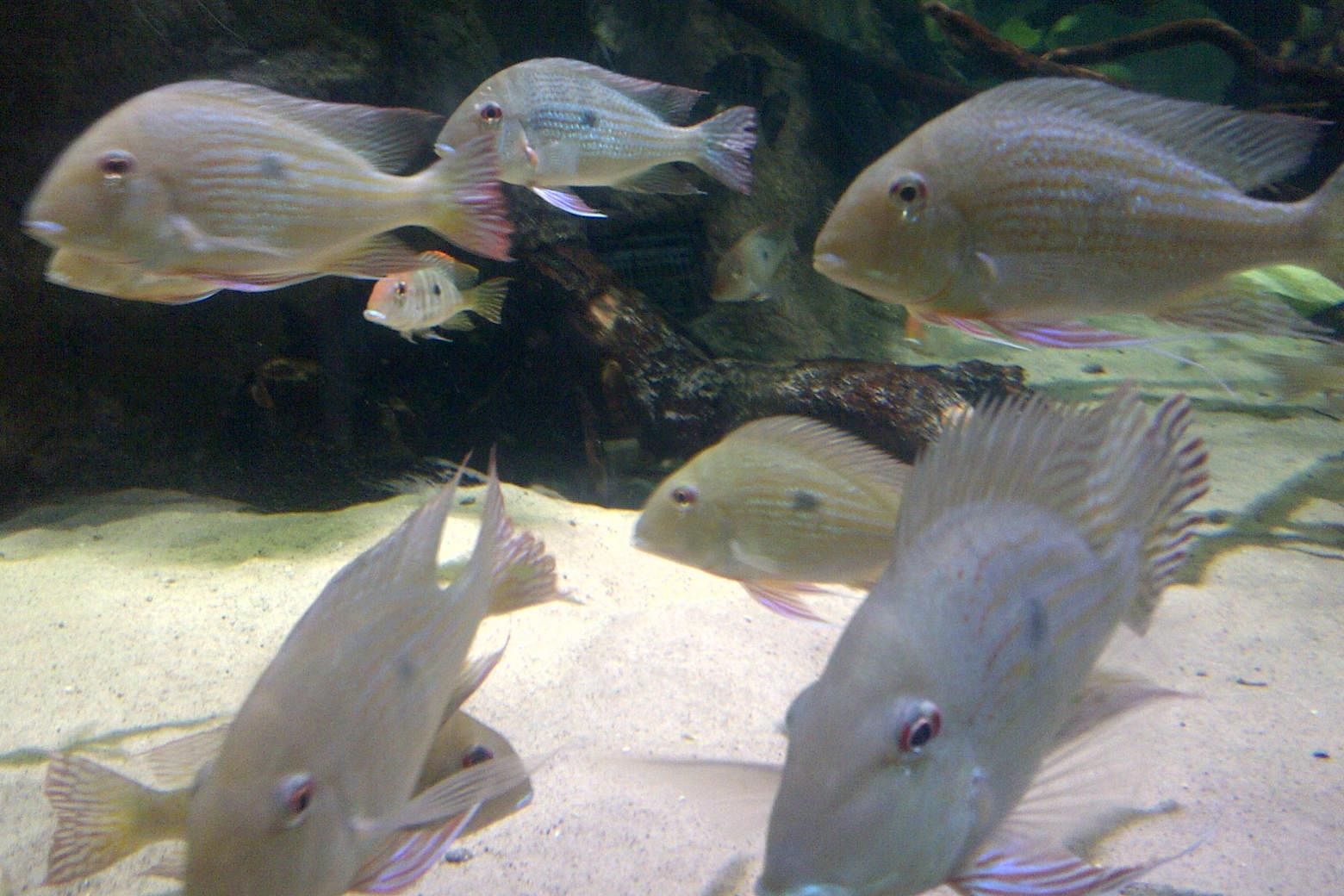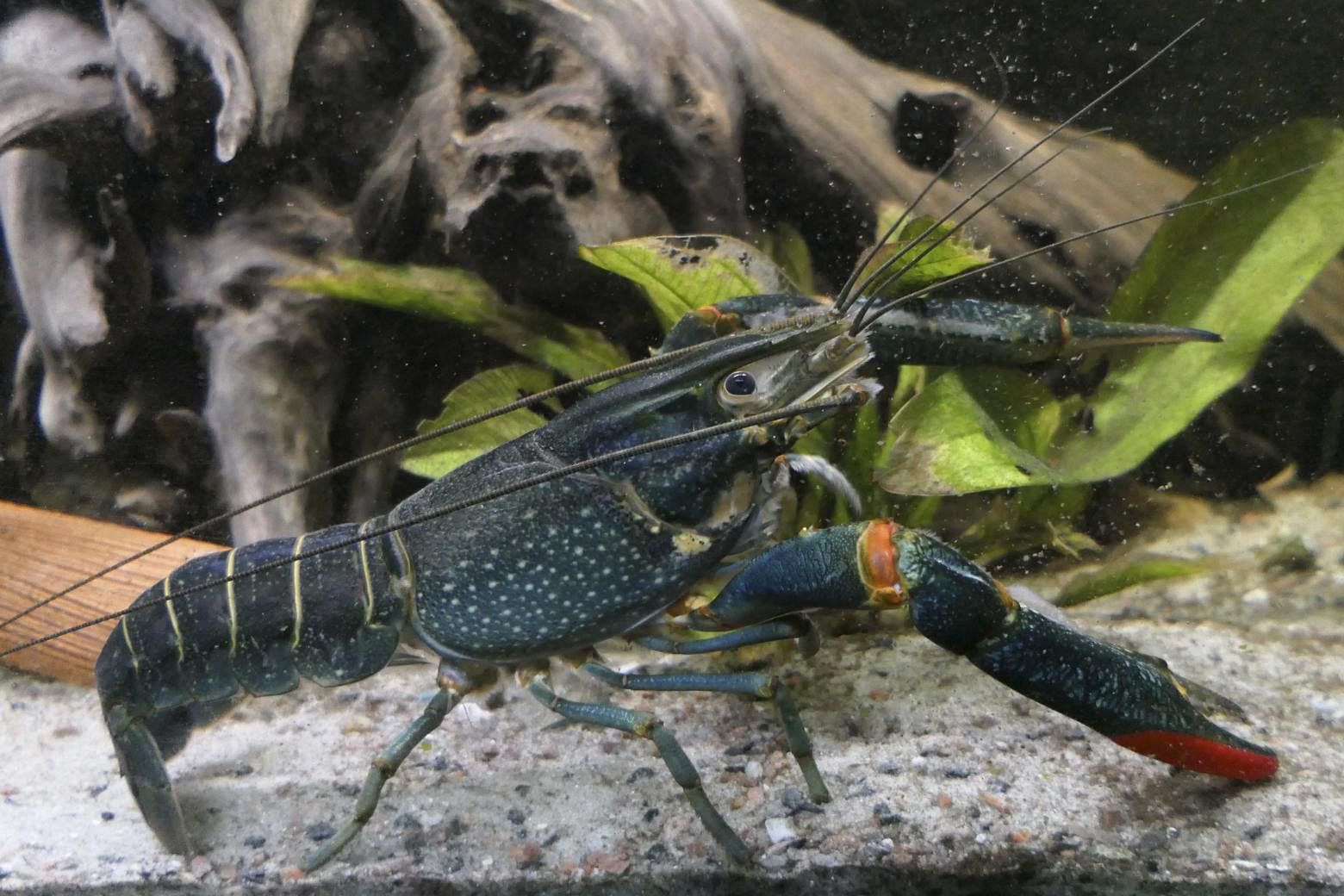From foreign mussel to American bullfrog: A guide to invasive species in Singapore
Sign up now: Get ST's newsletters delivered to your inbox

Examples of invasive species that can now be found in Singapore (clockwise from top left): American bullfrog, red-eared slider, golden apple snail, Australian red-clawed crayfish, Geophagus altifrons.
PHOTOS: WIKIMEDIA COMMONS, BT FILE, ST FILE
Follow topic:
SINGAPORE - Invasive mussels from the Americas have invaded the Republic's northern coast, spreading fast and forming dense mats that nature groups fear could have a negative impact on native animals here.
Rare horseshoe crabs and the Asian green mussel are among the native species that could be muscled out by the American brackish-water mussel.
Last Friday (March 2), scientists at the National University of Singapore (NUS) said at a media briefing that they had uncovered the identity of this strange mussel first observed here in 2016. This was done through genetic work and comparisons of the mussel with museum specimens around the world. They found this was the first time that Mytella strigata has been recorded in Singapore waters.
What are invasive species, and what harm do they cause?
These are animals or plants from another region of the world that do not belong in their new environment, according to the United States' National Oceanic and Atmospheric Administration (NOAA).
"They can be introduced to an area by ship ballast water, accidental release, and most often, by people. Invasive species can lead to the extinction of native plants and animals, destroy biodiversity, and permanently alter habitats," said the NOAA on its website.
Since invasive species do not belong in the environment in which they are introduced, they lack natural predators that can keep their numbers in check.
Mr Lim Liang Jim, group director of the National Parks Board's (NParks) National Biodiversity Centre, said most alien species are known to be hardy and are capable of establishing quickly in new environments.

"They can multiply rapidly and compete with native species for resources such as food and shelter. In some cases, this can result in the disruption of native ecosystems. Alien species often pose a threat to native species which tend to have more specific niches," Mr Lim told The Straits Times.
The impact of the American mussel, observed to form clumps of up to 10,000 individuals, on local ecology is still being studied.
But Dr Serena Teo, one of the mussel study's lead researchers, said: "The Asian green mussel is widely cultured in South-east Asia. From our field studies, it appears that Mytella strigata would be a problem for fish farmers as it competes for space on mussel recruitment nets. This may have an economic impact as the much larger kupang would fetch a better price." The kupang is the colloquial name for the Asian green mussel.
However, Dr Teo, a senior research fellow at NUS' Tropical Marine Science Institute, pointed out that the Asian green mussel is a hardy species, and is considered an aggressive invasive species in the Americas. "It is unlikely to be easily trampled out," she said.
How do we manage invasive species?
Following news of the invasive mussel from the Americas, many readers wanted to know if they can be eaten. The NUS researchers do not recommend eating them as a way of reducing their numbers. For one, there is no way of knowing how much toxins are in them. Mussels are filter feeders and toxins they take in could accumulate.
Invasive species can be brought in by ships too. Dr Teo said countries such as Australia and New Zealand have biosecurity laws which control the human transport of organisms into the country.
The International Convention for the Control and Management of Ships' Ballast Water and Sediments seeks to control the transport of organisms in ship ballast water. Singapore acceded to the convention which came into force internationally on Sept 8 last year, she said.
Ballast tanks on ships are filled or emptied of seawater to keep a ship stable.
Under the convention, all ships in international traffic are required to manage their ballast water and sediments to a certain standard. The International Maritime Organisation website said ships will eventually need to install an on-board ballast water treatment system, although an intermediate solution would be to exchange ballast water mid-ocean, instead of at ports.
Invasive species can also be introduced into local environments through the pet trade. NParks tries to reduce this route by educating people against releasing animals or unwanted pets into parks and nature reserves.
Mr Lim said NParks works with various agencies and non-government groups, including volunteers, to deal with this threat.
He said: "Conservation management, legislation and public education are the key measures used to deal with this threat. The most effective way to deal with the impact of invasive species is to prevent invasions before they even occur."
Those caught releasing animals can be fined up to $50,000 under the Parks and Trees Act.
What other invasive species are there in Singapore?
According to NParks, these are some other examples of invasive species that can now be found in Singapore:
Red-eared slider (Trachemys scripta elegans)

This turtle species, native to eastern and central US, is commonly sold in the pet trade. The terrapins are highly productive and can quickly establish a feral population when introduced into reservoirs. Their presence can affect native freshwater turtles such as the Malayan box turtle. A female slider can produce up to a dozen eggs twice a year, and out-breeds the Malayan box turtle, for example, which lays only two eggs each time.
American bullfrog (Lithobates catesbeianus)

These bullfrogs from the Americas are known to breed prolifically and compete with local frogs for food and space. Brought into Singapore as part of the food trade, this frog is commonly sold at coffee shops and markets for food, and in the pet trade as pet or bait for other aquatic animals.
Cichlids (Geophagus sp)

A common discard from the aquarium trade, fish such as Geophagus altifrons are naturally found in the Amazon River basin in Brazil. They are also known as earth-eaters for their feeding habits. As they search for food, they gulp and stir up reservoir sediments.This increases the murkiness of the water and may cause nutrients to be released from the sediments, affecting reservoir ecology.
Australian red-claw crayfish (Cherax quadricarinatus)

A commonly-sold ornamental aquarium species in Singapore, the crayfish is a potential carrier of diseases that can infect other invertebrates. It is native to Australia, but is posing a problem in many other countries where they are considered invasive, including places such as Jamaica, Mexico, Puerto Rico and South Africa.
Golden apple snail (Pomacea canaliculata)

Classified as a pest, the golden apple snail originally from South America is among the top 100 of the world's most invasive species. In 2012, the European Union banned all imports of snails belonging to the genus Pomacea because of their destructive impact on agriculture.
According to the International Union for Conservation of Nature, they were likely to have been introduced to South-east Asia as a food item. The snail lays pink eggs in clusters of hundreds up to a thousand, one reason why native species of apple snails, which lay eggs only in the hundreds, are being crowded out.
Source: NParks, IUCN, Catalogue of Life

